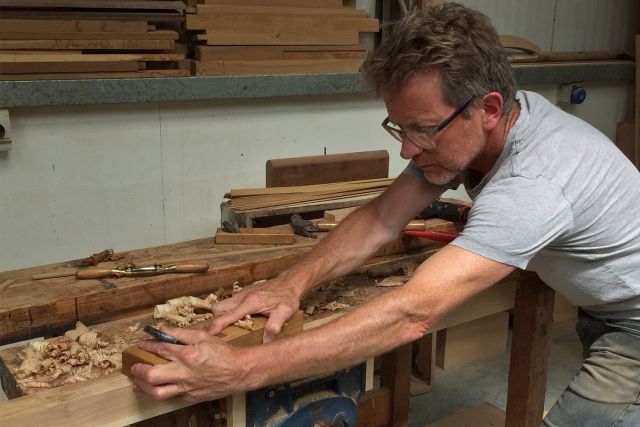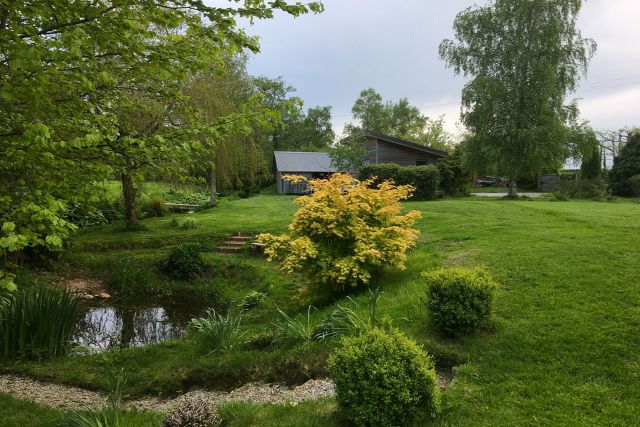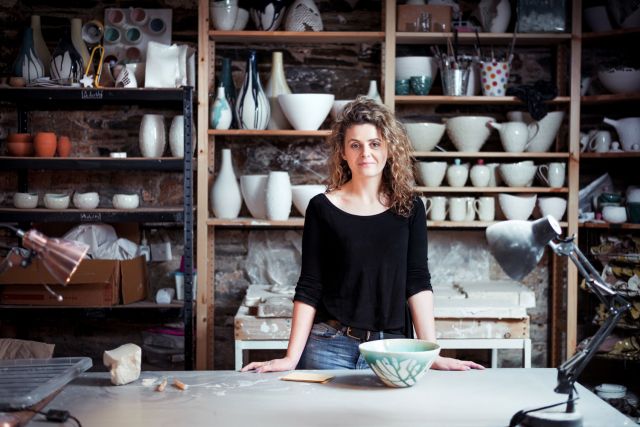The initial inspiration for this challenging shape came from observing wood shavings on Stephen’s bench. To create the piece in wood, Stephen began by making a series of foam models until he had one he felt happy with. The actual construction involved making several Japanese-style pull planes, used to shape the complex inner curves of the desk.
Height 750 mm
Length 1800 mm
Width 900 mm

 FUSION II chair side.jpg.jpeg)
 641.jpg.jpeg)
 workshop1.jpg.jpeg)
 FUSION II detail.jpg.jpeg)
Stephen O’Briain
- Cabinetmaker
- Borris, Ireland
- Master Artisan
The artist who listens to wood
- • Stephen is a third generation cabinetmaker
- • He works with timbers including walnut, maple, oak and ash
- • He was selected for the Irish Portfolio Critical Selection 2019-20
Stephen O'Briain started out as an artist, studying painting at the Crawford School of Fine Art in Cork, Ireland. But woodworking was in his family, so perhaps it was inevitable that he would follow his mother and grandfather into the craft. Inspired by the work of Russian master cabinetmaker James Krenov, Stephen began woodworking as a hobby, but within a year it had become a full-time job. “I have always been interested in how things are put together,” he says. “Then there’s the satisfaction of working with my hands and acquiring new skills. But most of all I think I enjoy the creative process of coming up with new ideas and then working out how to realise those ideas.”
Read the full interviewWorks
Photo: © Roland Paschhoff

Photo: © Roland Paschhoff
In 2009, Stephen started experimenting with the possibilities of building up forms using repeated three-dimensional patterns. This desk, one of two built between 2015 and 2017, is one of the larger examples in the series. The wave-like patterns were built up in layers, each shaped by a spindle moulder using a technique developed in Stephen’s workshop. Before being assembled, all the layers had to be finished with spokeshaves and scrapers, in order to get them to fit perfectly together.
Height 750 mm
Length 2000 mm
Width 1000 mm

Photo: © Roland Paschhoff
First built in 2009, this limited-edition chair is constructed using the same block laminating techniques as seen in Stephen’s SOFA sideboard, with most of the final shaping carried out with spoke shaves and scrapers. The chair comes with an optional woven Danish cord or cane seat. Since the prototype, Stephen has made several small modifications to the design, but in 2018 he made a form that was more radically different, where none of the original components remained exactly the same.
Height 800 mm
Length 700 mm
Width 560 mm

Photo: © Stephen O’Briain
This was the second of two similar sideboards constructed in 2008 and 2009. Around this time, Stephen’s work became increasingly organic and sculptural. The basic form was built up using block-laminating techniques. It was then shaped by hand using a combination of planes, spokeshaves and scrapers.
Height 650 mm
Length 2400 mm
Width 550 mm













